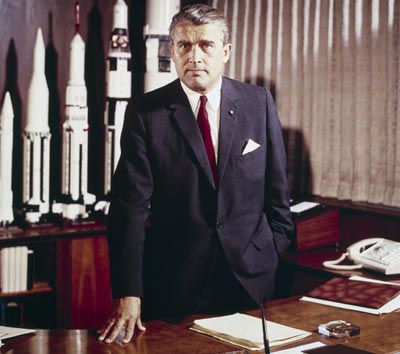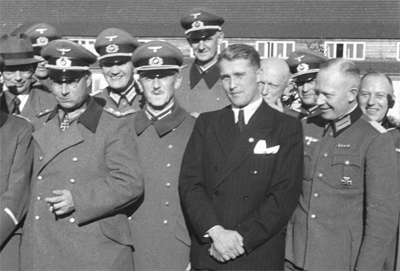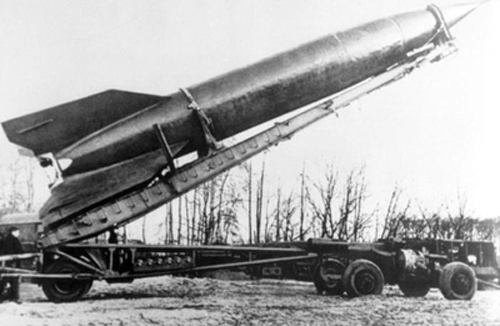Space Über Alles
A new study of the German rocket genius behind the American space program reflects his complexity
Tibor Krausz
The Jerusalem Report, April 14, 2008
On July 20, 1969, when Neil Armstrong and Buzz Aldrin stepped on the moon in a defining moment of human achievement, the lion’s share of the credit for their mission was a German rocket scientist’s due. So much so, on a recent top-100 list of aviation pioneers, industry professionals ranked Wernher von Braun second only to the Wright Brothers in importance, ahead of Leonardo da Vinci, Ferdinand von Zeppelin, William Boeing and Charles Lindbergh.
That’s despite an awkward biographical detail: von Braun was once a card-carrying Nazi, and an SS officer at that.

His career, from wunderkind working for the Nazis’ secret ballistic missile program to celebrated architect of NASA’s space program, provides a classic template for the moral ambiguities wrapped up in scientific progress and the often dubious character of its makers. His biography is a moralist’s palimpsest where (re)interpretations of his actions can be neatly superimposed over one another, especially in view of his illustrious postwar career. Was von Braun a dissembling evil genius? A politically misguided visionary? An amoral, calculating pragmatist? Was he all three?
In Michael J. Neufeld’s massive new biography, “Von Braun: Dreamer of Space, Engineer of War,” the German rocketeer is a mixed bag of a man. At times, the lifelong spaceflight enthusiast comes across as a gifted and driven megalomaniac who loves his ballistic gadgets (which he’s designing excitedly with spaceflight in mind), but cares little about their subversion as weapons of destruction. “It was immaterial to [von Braun],” a British reporter wrote, following an interview with the German engineer in 1945, “whether [his rockets] were fired at the moon or on little homes in London so long as they worked efficiently.”
At other times, von Braun is more like a penitent (somewhat still in denial) who, with the benefit of hindsight, rues the role he was once co-opted to play in Nazi crimes. “I never knew what was happening in the concentration camps,” he told science-fiction writer Arthur C. Clarke. “But I suspected it, and in my position I could have found out. I didn’t and I despise myself for it.”
To his credit, Neufeld, director of the Space History Division of the Smithsonian’s National Air and Space Museum in Washington D.C., doesn’t reduce von Braun’s complex personality to comforting Manichean certainties. In his view, von Braun was no mad or evil scientist; he was a deeply flawed yet ultimately civilized man, whose privileged background, gilded existence and driving ambition blinded him to his complicity in heinous crimes.
A scion of prominent Prussian aristocrats, von Braun was, by most accounts, a proud German nationalist but never a staunch Nazi. He was a political opportunist willing to sell his skills and services to Hitler in exchange for funding and support for his then-futuristic ballistic missile program at Peenemunde, on the Baltic Sea. The precocious engineer, still in his 20s, struck a “Faustian bargain,” in Neufeld’s words; he even became a token member of the SS in order to further his dream of flying one day to the moon.
Yet his handlers were interested not in von Braun’s flights of fancy but in his ground-breaking ballistic missile dubbed V-2, whose range was long enough to rain terror on Britain. Von Braun was okay with that, so long as he had government support for his work. And if, once only a “miracle weapon” could save Germany from defeat, the stepped-up pace of production entailed slave labor by inmates from Buchenwald and elsewhere, so be it. “If [von Braun] wished to have money for rocketry,” Neufeld writes, “to have a career... [and] to keep himself out of danger, he had to participate in stoking the fires of hell. And he did.”
In a telling episode, von Braun approaches a French physics professor conscripted for slave labor, asking for his help in the fine-tuning of his V-2 rocket (the first ballistic missile ever to reach suborbital flight). “I refused[d] him bluntly,” the Frenchman recalled shortly after the war, “[nonetheless,] he tried several times to improve my lot.” Yet some 20,000 slave laborers did die and despite his later protestations of ignorance, von Braun must have been aware of the prisoners’ inhuman treatment by SS guards.
Then again, here was a man who, while finding refuge at war’s end in a luxurious alpine redoubt, waxed lyrical about the “excellent” hotel service as the Red Army was wreaking havoc nearby.
* * *
The V-2 missile debuted in September 1944 during German attacks on liberated Paris and on London. By then, an increasingly disillusioned von Braun was ready to jump ship and pursue his dreams elsewhere. “The U.S. Army became his deus ex machina,” Neufeld writes, “rescuing him from the potential consequences of his actions” — and from planned kidnapping by the Russians.

From the start, the Cold War played out as much a technological contest as an ideological one with scientific advances hailed by the opposing camps as justifications of political doctrine. In October 1957, the Soviet Union ushered in the “Space Age” by launching Sputnik, the first manmade satellite to orbit earth, and sent the US scrambling to do one better. In 1961 President Kennedy pledged that before the decade was out the US would put the “first man on the moon.” By 1969, the stars and stripes had duly been planted in the lunar sand.
Von Braun had been instrumental in that.
In May 1945, the German engineer, recently appointed professor (the Reich’s youngest) by Hitler who’d also rewarded him with the Knight’s Cross, approached a U.S. Army unit with the plea of “Take me to Ike” (Dwight D. Eisenhower). Treating GIs “with the affable condescension of a visiting congressman,” as one recalled, the German offered his services to the Americans, not as an enemy captive but as an equal.
He found ready takers. With the Red Army on a roll across much of liberated Europe, new geopolitical realities trumped demands for justice and the moral obligation to bring former Nazis to justice was overridden by a need to recruit useful new allies from among them. In Project Paperclip, a top-secret military brain drain, several hundred German specialists from Peenemunde were spirited away from occupied Germany and put to work on the development of guided ballistic missiles at Fort Bliss, Texas. Von Braun was happy to comply. Almost immediately, however, he began calling for “crossing the last frontier” and establishing the “space superiority” of the U.S. He envisioned a space station, manned moon landing, and even a mission to Mars — projects that were still the stuff of out-there science fiction.
A dashing ladies’ man with matinee idol looks — tall, handsome, blond, blue-eyed — von Braun soon became a poster boy for the future-is-here visionary out to conquer space. A relentless popularizer, he lectured about space travel, wrote books, appeared in magazine features, spoke on radio, and starred in educational films by Walt Disney. The Carl Sagan of his day, the erstwhile Nazi (still addressed by his German honorific as “The Professor”) metamorphosed into a popular icon of the contemporary American scientific pantheon. Life magazine featured the “Seer of Space” on its cover and The New York Times declared him a “prophet of the Space Age,” who looked like a “cherubic Mephistopheles” with his wispy blond locks. Von Braun’s unwholesome past was rarely mentioned and he carefully airbrushed inconvenient details out of his memoirs and a Hollywood biopic, “I Aim at the Stars” (1960), starring Curt Jurgens.

When the Soviets launched Sputnik, von Braun was stunned, a colleague recalled, as if suddenly “vaccinated with a victrola needle,” pleading with his American bosses: “For God’s sake, turn us loose and let us do something.” Within four months, the U.S. had its own satellite in orbit and von Braun became, in Neufeld’s words, “a bona fide American hero, the Western world’s most prominent gladiator in a celestial contest with the Soviets.” It was the most successful self-rehabilitation of any former Nazi.
The German went on to lead, as its first director, NASA’s Marshall Space Flight Center in Huntsville, Alabama, in charge of engineering the Saturn rockets, which would propel the historic Apollo 11 mission to the moon. By the time of his untimely death of cancer at 65 in 1977, von Braun had become, Neufeld writes, “the most influential rocket engineer and spaceflight advocate of the twentieth century.”
Although his place in aviation history is secure, von Braun remains a controversial figure -- visionary pragmatist to many, war criminal to others. His contribution to Hitler’s war efforts was ultimately minor, yet it was more by chance than design. By the time the V-2, Hitler’s promised “miracle weapon,” took to the skies at the end of 1944, it was too late for it to make an impact in a war already lost. Under different circumstances, von Braun’s brainchild might have killed countless thousands across Europe. “Once the rockets are up, who cares where they come down?” he once offered.
Neufeld reserves judgment on von Braun’s frequently cavalier attitude and callous means in pursuit of a lifelong dream, letting anecdotal and documentary evidence make the case for or against. Yet despite the fascinating insight it grants into the German engineer’s conflicted character in all his complicity and complexity, “Von Braun” makes for a grueling read.
Curatorial exactitude comes with Neufeld’s territory, but his magnum opus often suffers for it. His year-by-year retelling of von Braun’s career is mired in reams of extraneous detail irrelevant to anyone but a specialist. The result is a whopping gate-stopper of a book, a closely typed hardback of almost 500 pages. For dozens of pages at length, we get bogged down in verbose minutiae, rendered in the lifeless prose of academe, about petty collegial squabbles or dreary bureaucratic back-and-forth.
With so much dead weight, even the unflappable von Braun couldn’t get this biography airborne.